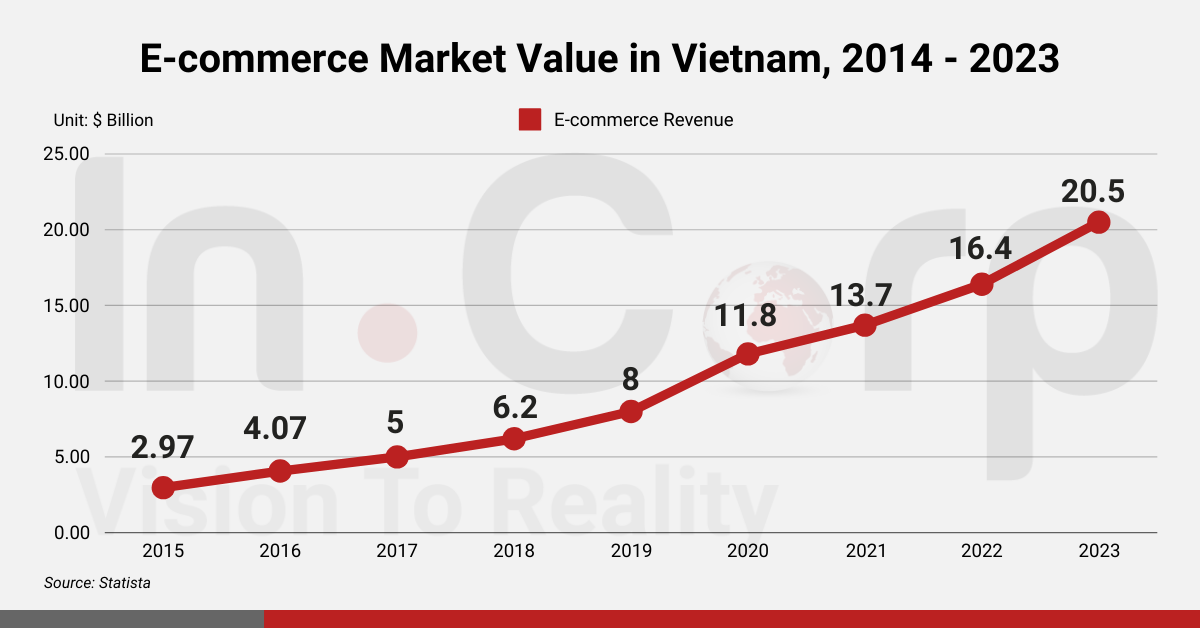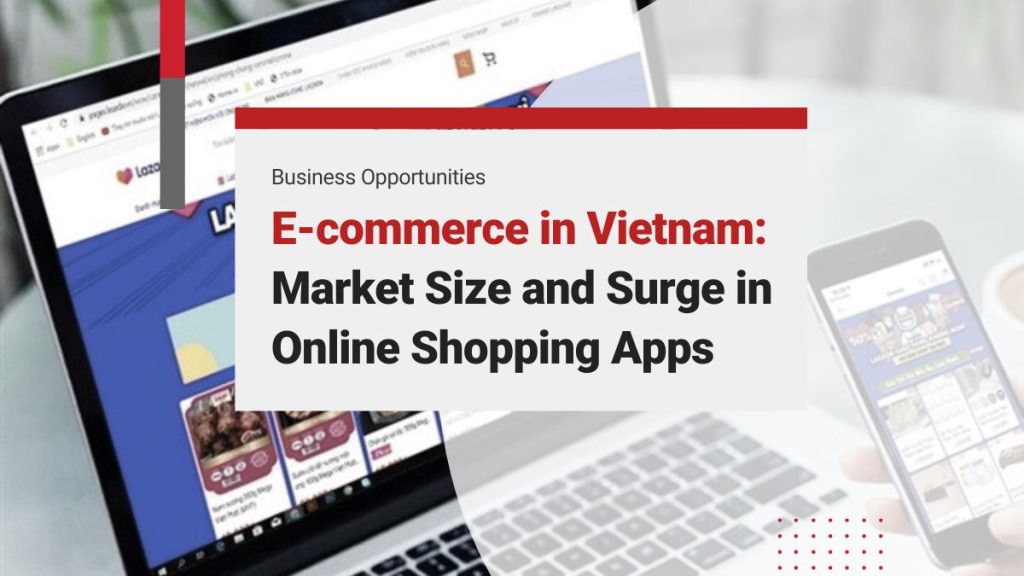The imposition of nationwide lockdowns and social distancing regulations due to the COVID-19 outbreak expedited a notable transition towards online shopping. It drove Vietnam’s e-commerce sector forward, and this trend also continued in 2021 & 2022 without showing any signs of slowing down.
With growing foreign investments, favorable regulatory conditions, and improved internet accessibility, the country’s e-commerce sphere is thriving. Projections suggest that Ho Chi Minh City and Hanoi will emerge as significant hubs, with the digital economy poised to reach US$220 billion by 2030, presenting abundant opportunities for global investors. This article delves into the reasoning and strategies behind establishing e-commerce in Vietnam amidst its vibrant digital economy.
Interested in E-commerce in Vietnam? Check out InCorp Vietnam’s Incorporation Services
Vietnam E-commerce Market Size: Benefits of E-commerce Investors

Vietnam entered its technological era on November 19th, 1997, when citizens had just gained access to the Internet. Over nearly three decades, the country has evolved as the highest number of internet users worldwide. It aimed to achieve almost 80% internet coverage by 2023. Mobile devices, especially smartphones, drive internet usage, becoming a daily habit for many Vietnamese.
In the past several decades, Vietnam has experienced remarkable technological advancements. The population has become extensively dependent on digital devices, and smartphones, integrated into daily life. With one of Asia’s highest smartphone penetration rates, Vietnam is a key global hub for smartphone production. This technological evolution underscores the country’s growing significance in the digital landscape and its pivotal role in the worldwide tech industry.
E-commerce in Vietnam is estimated to be worth US$14.70 billion in 2024, poised to reach US$23.77 billion by 2029 with a CAGR of 10.09% (2024-2029). E-commerce revenue is surging in Vietnam, driven by new market formations and growth opportunities in established markets. East and Southeast Asia, with expanding middle classes and limited offline shopping infrastructure, are key drivers of this trend.
- The Vietnamese government is promoting a cashless society to reduce cash transactions to under 10% of total payments, reaching 70% of the banking population. They’ve recently approved a national e-commerce growth master plan. It is aligned with Fourth Industrial Revolution strategies, aiming to establish a digital economy and drive national digital transformation.
- Vietnam boasts one of the most favorable legal environments for e-commerce in the ASEAN region. The country has passed five out of six pieces of legislation aimed at regulating e-commerce activity. This sector has significantly influenced the recent growth of the transportation, distribution, and fulfillment services ecosystem.
- The e-commerce industry was projected to generate US$14.81 billion in revenue for 2022, with a forecasted growth rate of 16.98% (CAGR 2022-2025), reaching a market volume of US$23.71 billion by 2025. According to Statistica data, the number of e-commerce platform users is expected to reach 70.9 million, with a user penetration rate of 70.1% by 2025.
- Vietnam is anticipated to become the fastest-growing e-commerce market in Southeast Asia by 2026, as per a survey by Facebook and Bain & Company. The projected gross merchandise value of e-commerce is US$56 billion, 4.5 times the predicted value in 2021.
- The report highlights Southeast Asia’s leadership in digital transformation, with Vietnam being a top performer. By the end of 2021, Vietnam had 53 million digital customers, 70% of the population had internet access, and 53% used e-wallets for online payments.
- In 2021, online consumer purchases in Vietnam increased by 50% compared to 2020. The number of online retailers grew by 40%, resulting in a 1.5-fold rise in total online retail sales.
Read More: Small and Medium Enterprises in Vietnam: Business Size of Companies
Types of E-commerce Business in Vietnam
Before delving into how to begin selling things online in Vietnam, it’s necessary to understand the most common types of e-commerce businesses.
Online Retail Market
In Vietnam, online retailers manage their inventory and directly sell their products. They utilize their advertising channels to leverage their online presence to expand their customer reach.
Online sellers in Vietnam procure goods they wish to sell and store them until they are sold. Typically, these sellers own traditional retail shops seeking to boost their income through online sales.
Online Marketplaces
It serves as a virtual hub for businesses in Vietnam, offering a centralized platform for vendors to showcase their products. This consolidated approach allows customers to explore diverse offerings from multiple sellers in one convenient location, simplifying purchasing.
Notable local online markets like Tiki, Sendo, Shopee, and Lazada coexist with global giants such as Amazon, Alibaba, and eBay, broadening the spectrum of choices for both sellers and buyers. Transactions and advertising activities are seamlessly facilitated through the platform, enhancing the overall shopping experience and attracting a broader customer base.
Online Classifieds
It resembles online markets but differs in payment methods. In this case, the payments are handled directly between buyers and sellers without website mediation. In Vietnam, online classifieds operate similarly to online marketplaces, with the key distinction being the absence of payment processing on the website. Sellers control their advertisements and manage transactions independently, facilitating direct payments from buyers to sellers for products purchased.
Establishing a E-commerce Company in Vietnam? Find out which business types are optimized for your choice now!
E-commerce’s Online Shopping Trend in Vietnam
The leading e-commerce websites now offer games and live-streaming services. Consumers turned to online platforms for both essential shopping and entertainment during social distancing. To enhance engagement, e-commerce apps must include interactive features like games and live streams, fostering stronger customer connections.
- Vietnamese retailers are increasingly adopting omnichannel strategies, aiming to enhance customer experiences. These strategies allow customers to transition seamlessly between physical stores and e-commerce platforms. For instance, shoppers can browse items in-store and make purchases online, or vice versa, promoting convenience and fluidity. Key players like Mobile World, FPT Corp, and major hypermarket retailers like Big 5 are leading this trend.
- In Vietnam, consumers rely heavily on shipping and payment methods when shopping online. Cash on delivery (COD) is popular as it allows customers to inspect items before purchase. Concerns about card fraud lead many to prefer using trusted retailers or secure payment platforms like PayPal for online transactions. These factors greatly influence consumer decisions in the Vietnamese online market.
- The demand for contactless transactions, accelerated by the acceptance of fintech and the COVID-19 pandemic, is reshaping payment preferences. Although cash still dominates e-commerce transactions, this trend is expected to change by 2025, with a shift towards digital payments. Affordable mobile internet, driven by Vietnam’s expanding 4G infrastructure, facilitates widespread adoption of e-commerce and digital payments. According to a Rakuten survey, 71% of Vietnamese respondents used cash on delivery, while 54% favored mobile wallets for online shopping.
- Momo and Zalo are emerging as dominant players in Vietnam’s payment landscape. In recent years, numerous e-commerce merchants have partnered with mobile payment providers like Momo and Zalo Pay to facilitate mobile e-commerce transactions. For instance, Co.op Smile and Co.op Food have collaborated with Momo, while Big C has teamed up with Zalo Messenger, underscoring the growing importance of mobile payment solutions in enhancing sales potential.
- An increasing trend among urban consumers, especially those with busy schedules, is the growing reliance on delivery services. Foody JSC pioneered third-party grocery delivery with its Market Now service, enabling customers to choose their preferred hypermarkets or supermarkets and select items for purchase. The delivery service procures the products to customers’ homes, presenting hypermarkets and supermarkets with a new avenue to engage with consumers amidst their demanding routines.
- Vietnam’s thriving e-commerce landscape is exemplified by successful local platforms like Tiki, Sendo, and Thegioididong, fueled by investments from Japan, Germany, the United States, South Korea, China, and Singapore.
- Merchants should prioritize mobile commerce to outpace domestic competition: Only 19% of local merchants’ websites are mobile-friendly. According to JP Morgan, apps are favored over browsers for online purchases in Vietnam, comprising 62% of all transactions.
- The volume of visitors underscores the dominance of foreign e-commerce platforms in the market. Ministry of Information and Communication data from February 2022 reveals:
- 78.5 million users on Shopee,
- 14.8 million on Lazada,
- 14.1 million on Tiki, and
- 12.7 million users on Good Market (Vietnam).
The Southeast Asian market presents attractive investment opportunities due to this rapid growth. The pandemic heightened online transactions, and experts predict sustained e-commerce growth post-pandemic, shaping new consumption patterns. Vietnam prioritizes digital economy development, aiming to enhance IT and e-government platforms, bolster consumer trust, expand infrastructure, and promote e-commerce in key sectors and regions.
How is Technology Shaping the E-commerce Market in Vietnam
E-commerce in Vietnam has experienced remarkable growth, primarily attributed to the impact of COVID-19. The pandemic reshaped consumer behavior, fueling an unprecedented expansion of online commerce. This shift underscores Vietnamese consumers’ growing confidence in digital transactions, indicating a lasting trend.
Vietnam leads in adopting innovative e-commerce technologies, such as database systems aiding goods delivery businesses in identifying popular products and assisting sellers in acquiring goods efficiently.
In Vietnam, two main technical aspects are employed in the transportation stage:
- In Vietnam, online shoppers expect swift deliveries, forcing delivery companies to streamline processes for faster service. Advanced technology is crucial in assisting shippers to promptly estimate incoming goods, load them efficiently, and determine optimal delivery routes.
- Secondly, Vietnamese logistics firms must enhance warehouse automation to meet these demands. Globally, warehouse automation is projected to reach a market capitalization of about US$70 billion by 2026, indicating its essential role in logistics strategies. Integration of such technology benefits all stakeholders in the Vietnamese e-commerce ecosystem, promising improved efficiency and customer satisfaction.
Vietnam Online Shopping Apps in the E-commerce Industry
Below, we have listed the top 5 e-commerce companies in Vietnam. It includes
Shopee
A prominent e-commerce platform, Shopee has a user-friendly interface and effective promotional campaigns. It operates in seven countries: Vietnam, the Philippines, Thailand, Indonesia, Malaysia, Brazil, and Taiwan.
Mobile World Group
Established in March 2004, Mobile World Joint Stock Company is the proprietor of one of Vietnam’s largest electronic sales platforms, thegioididong.com. In 2020, Mobile World Group (MWG) commanded an impressive 50% market share in Vietnam’s retail market for mobile devices. Recognized among the top 100 retailers in Asia-Pacific, Mobile World’s e-commerce platform attracts a substantial 31.4 million visitors monthly, securing its position as the second-largest e-commerce platform in Vietnam.
Tiki
Established in March 2010, Tiki is one of Vietnam’s largest e-commerce platforms. It offers the innovative TikiNow service, which enables customers to receive orders within 2 hours.
With a vast inventory comprising over 500,000 products from 6,500 brands, Tiki’s platform caters to a wide range of customer needs. Despite a slight decrease from last year, Tiki’s website still draws nearly 22.2 million monthly visitors, securing the 4th spot for iOS and Android app downloads. International investments, such as JD.com’s VND 1,000,000 Million (40.57) in Tiki, underscore the influence of foreign players.
Lazada
As one of Vietnam’s largest e-commerce platforms, Lazada offers various products ranging from furniture and electronics to fashion, beauty, health, toys, and sports equipment. This company is under the umbrella of Alibaba, a multinational e-commerce corporation that oversees its operations in various countries, including:
- Thailand
- Indonesia
- Singapore
- The Philippines
- Malaysia.
Sendo
In September 2012, Sendo emerged as Vietnam’s inaugural online e-commerce platform, boasting an expansive delivery infrastructure covering provinces and cities nationwide. With around 11 million monthly visits, Sendo stands as one of Vietnam’s foremost e-commerce platforms.
How to Start an E-Commerce Business in Vietnam
Foreign individuals aiming to venture into Vietnam’s e-commerce sector must fulfill the legal requirements outlined by Vietnamese law and complete specific procedures. This typically involves:
- Obtaining various certificates like investment and business registration certificates
- Seeking approval from the Ministry of Industry and Trade
- Registering their website in Vietnam
- Additional licenses might be necessary depending on the nature of their business activities.
We made the most detailed step-by-step guide for Company Incorporation in Vietnam for investors, now available as an interactive checklist:

Conclusion
According to Google’s report on Vietnam, 8 million new digital consumers emerged in the first half of 2021, with 55% residing outside major cities. As people adjusted to post-pandemic life, 60% of surveyed consumers planned to sustain their e-commerce spending in 2022, while 30% intended to increase it.
Vietnam’s Gross Merchandise Value (GMV) soared to US$21 billion in 2021, which marked a 31% Year-on-Year (YoY) surge. Projections suggest a compound annual growth rate (CAGR) of 29% and will anticipate a US$57 billion value by 2025. With 16 free trade agreements (FTAs) among ASEAN nations, Vietnam fosters an advantageous regulatory environment for e-commerce startups, supported by the government’s commitment to digital transformation and potential foreign investments.
About Us
InCorp Vietnam is a leading market entry and corporate services firm in Vietnam. We are part of InCorp Group, a regional leader in corporate solutions that encompasses 8 countries in Asia-Pacific, headquartered in Singapore. With over 1,200 legal experts serving over 15,000 Corporate Clients across the region, our expertise speaks for itself. We provide transparent legal consulting, setup, and advice based on local requirements to make your business fit into the market perfectly with healthy growth.
Don’t take our word for it. Read some reviews from some of our clients.










